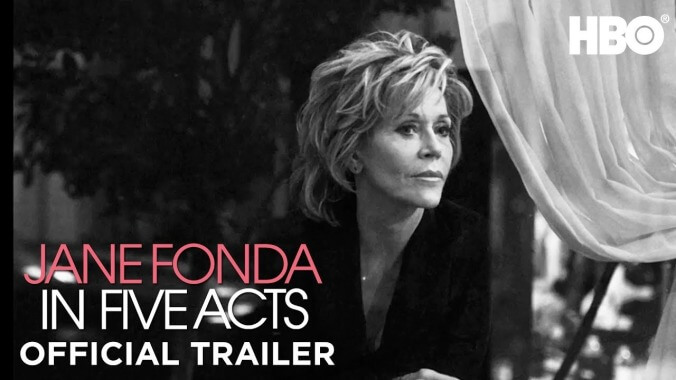Jane Fonda In Five Acts traces disparate phases of a fascinating life

Jane Fonda has donned so many personas over the years—Hollywood starlet, Barbarella sex kitten, Hanoi Jane, workout queen—it doesn’t even seem possible that the same person lived through all of these seeming disparate eras. Jane Fonda In Five Acts, Susan Lacy’s new HBO documentary, expertly breaks down Fonda’s different stages with solid through-lines between the false-eye-lashed bombshell, science-fiction pinup, and the fresh-faced mini-commune dweller only a few years later. Significantly, the first four “acts” of the film are titled by the name of the significant male influence in Fonda’s life at that particular time: Her father, Henry; first husband, director Roger Vadim; second husband, activist Tom Hayden; third husband, mogul Ted Turner; until we and Jane finally arrive at the fifth act of Jane finding herself.
While that setup is chronological, Lacy’s thematic detours are not. For example, Fonda specifically remembers how her striptease opening credits of Barbarella were filmed—“I drank so much vodka to do that”—only to have to do it all over again when it’s discovered that a bat flew in, ruining the footage. Fonda had her daughter Vanessa while married to Vadim, and that Barbarella phase also brings up for her what it means to be a mother and a woman, without having had much of a role model herself (her mother took her own life when Fonda was a child). Fonda also reveals how her mother’s suicide helped inform her breakthrough role in the Depression-era dance-marathon movie They Shoot Horses, Don’t They?, calling it the first time she made a film “that was about something.” She credits director Sydney Pollack for actually asking her opinions on set (something her own husband never did), helping her tap into a strength she hadn’t realized existed in herself. She becomes, as she puts it, “fierce,” even transforming her bombshell blondness to the Klute shag she was so aligned with for much of the ’70s: “I had my first hair epiphany,” she says of the first of many such transformations.
Throughout, the documentary offers glowing praise of Fonda that falls just short of fawning. Frankly, it’s difficult not to be impressed. Seventy-eight at the time of filming, the formidable Fonda personifies courage and strength in her interviews, even as she reveals tremendous vulnerabilities. She’s repetitively contrite about the darkest chapter of her life—the Hanoi Jane photo that showed her laughing while sitting atop an anti-American aircraft in North Vietnam. She’s apologized for that behavior before, and Lacy gives her ample time to double-down on that explanation—maybe too much time, as the doc stretches past the two-hour mark. Fonda herself sums up that time period rather succinctly: “I’m proud of most of what I did, but I’m very sorry for some of what I did.”








































